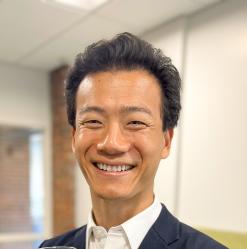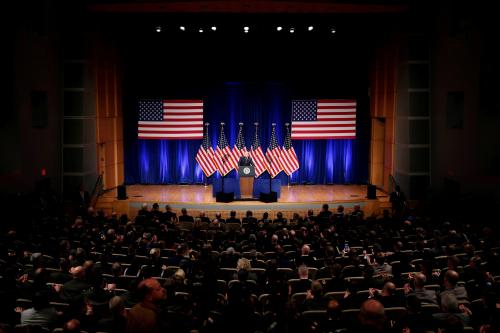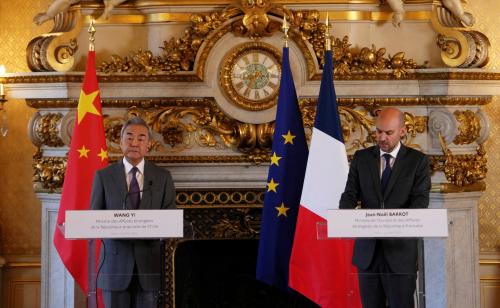Kyle Chan joined the Brookings Institution in October 2025 as a fellow in the John L. Thornton China Center. He is also a 2025 fellow with the Penn Project on the Future of U.S.-China Relations. Previously, he was a postdoctoral researcher in the Sociology Department at Princeton University and an adjunct researcher at the RAND Corporation.
In the following interview, he discusses his experiences and career researching China’s technological development with Ryan Hass, director of the China Center and the Chen-Fu and Cecilia Yen Koo Chair in Taiwan studies.
Ryan Hass:
Kyle, welcome to Brookings. Would you tell us about your backstory and how you became interested in China?
Kyle Chan:
I grew up in Los Angeles as the child of immigrants from Hong Kong. While I always had a personal interest in learning about China, it wasn’t until I started traveling to China during college that I became fascinated by the “puzzle” of China’s development. I saw a country that defied so much of the conventional wisdom on economic development and managed to transform itself dramatically within a generation. I remember being taken aback by the pace of change, the way that new highways and skyscrapers seemed to spring up like mushrooms. And I remember the heavy air pollution and the weary faces of migrant workers toiling away at construction sites or heading to their factory jobs.
Living in India was also a transformational experience for me. After college, I spent a few months volunteering at a nongovernmental organization in Delhi before starting a job in management consulting. Here was another rapidly changing country with similar aspirations and growing pains. But India seemed to operate in a fundamentally different way than China. It was more than just the fact that one was authoritarian, and the other was a democracy. I wanted to understand how these countries worked, not just politically or economically, but at a “systems level.” After a few years in consulting, I decided I wanted to go back to academia and do a Ph.D. in sociology. Princeton’s Sociology Department gave me incredible research training and the ability to conduct in-depth fieldwork in both countries over the course of several years.
Ryan Hass:
How did you get involved in studying China technology issues?
Kyle Chan:
I’ve long been interested in the social and organizational roots of what might seem like primarily technical achievements. As part of my doctoral dissertation, I chose to study China’s high-speed rail program, which is the ultimate megaproject of our lifetime. In a short span of time, China built the world’s largest high-speed rail network, which now transports more than 4 billion passengers a year on over 30,000 miles of track. While this is certainly an engineering feat, there are deeper institutional factors that enable China to build advanced infrastructure like this in the first place.
At the heart of it was a story about learning. China’s train manufacturers learned from foreign firms that were pushed to form joint ventures with their Chinese counterparts and share technology and know-how. China set up specialized research labs to study the latest in high-speed rail design and then developed its own models and platforms. China was not satisfied with simply paying foreign companies to build high-speed trains, but instead wanted to master the core technology itself.
And it wasn’t just bullet trains. I began to realize that China was doing this across a broad set of high-tech industries, from solar cells and telecom equipment to artificial intelligence (AI) and semiconductors. I wanted to understand the underlying patterns that appear across all these sectors. What are the policy tools that China uses to promote innovation? How do Chinese companies scale up so quickly? What happens as Chinese firms move up the value chain and start to challenge American and other established industry players?
Ryan Hass:
What is your diagnosis for how China has managed to build dominant positions in so many emerging technologies?
Kyle Chan:
I would highlight two factors here. One is the role of industrial policy. China has been very deliberate about identifying key technologies and targeting them with state support for years or even decades. This state support includes not just subsidies but help with financing, infrastructure, permitting, and even sales and marketing. Much of this happens at the local level, where provincial and city governments compete fiercely with one another to bring in investment and support their local industry champions. This process can lead to brutal price wars and overcapacity, but it can also produce formidable global competitors.
The other factor is the positive feedback loop created by China’s existing tech sectors and its broader industrial base. China’s recent emergence as an electric vehicle powerhouse is built on its existing strengths in consumer electronics, batteries, and traditional auto manufacturing. China’s rapidly developing robotics industry benefits from a vast network of suppliers for electric motors, sensors, and gearboxes. With the rise of AI and autonomous systems, these supply chain ecosystems increasingly overlap and reinforce one another. Progress in one area, like batteries or sensors, drives progress in many other overlapping industries, from drones to robotaxis.
Ryan Hass:
Are there lessons from China’s technological successes that are applicable to America, or are the two systems and situations so different as to render such comparisons moot?
Kyle Chan:
At a very broad level, I do think there are lessons the United States can learn from China. Some of these are even lessons that China originally learned from us. One is that active government support can be helpful, if not critical, to supporting progress in emerging technologies at a stage when they may not be commercially viable. In China, government investment funds, industrial parks, and pilot programs help companies scale up and bridge the “valley of death” from prototype to commercialization. When it comes to supporting innovation in America, we should recognize that markets and private capital have gaps and that there’s an important role for public sector support, particularly when the societal benefits are likely to be substantial but may unfold over a longer time horizon.
Another lesson is that effective industrial policy requires some degree of risk-taking. We Americans celebrate risk-taking in the private sector but are profoundly risk-averse when it comes to public programs. We let a single case like Solyndra haunt us for years. China takes more of a portfolio approach to industrial policy, tolerating some degree of failure and waste in support of broader sector-level progress. I believe we can have public programs with both strong mechanisms for accountability and a greater capacity for making bold bets on emerging technologies.
Ryan Hass:
Do you think American policy should focus on trying to slow down China’s technological progress, speed up America’s own technological advances, or some combination thereof?
Kyle Chan:
I used to be in the “run faster” camp when it came to how the United States should approach competition with China. Now I’m in the “run even faster” camp, seeing and understanding how quickly China is making progress across a wide range of sectors, from AI and robotics to biotech and clean energy.
There are certainly things we can do to slow China down in the short run. And there may be some things we can do to slow China down in the medium term. But the only real solution in the long run is for the United States to build on our unique strengths and invest in our own competitiveness. China is absolutely determined to become a global leader in technology. Chinese universities and labs are producing research at the global frontier in countless fields. Chinese tech companies and startups have proven that they can compete head-to-head with our best AI models and drug therapies. China has used industrial policy not only to catch up with the West but also to build an economy that’s more robust against our policy actions.
There are no shortcuts in the technology race with China. In the end, we have no other choice but to innovate and compete.
The Brookings Institution is committed to quality, independence, and impact.
We are supported by a diverse array of funders. In line with our values and policies, each Brookings publication represents the sole views of its author(s).








Commentary
Meet new fellow Kyle Chan, China technology expert
October 30, 2025